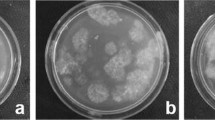Abstract
An improved protocol, including DNA extraction with Chelex, two amplifications with a nested primer set, and DNA purification by electrophoresis, made it possible to analyze nuclear rDNA sequences of powdery mildew fungi using at most several hundred conidia or 20 cleistothecia. Nucleotide sequence diversity of the nuclear rDNA region containing the two internal transcribed spacers (ITS1 and ITS2) and 5.8S rRNA gene derived from conidia and cleistothecia was investigated for four kinds of powdery mildew fungi including two isolates of the same species. The results showed that the nucleotide sequences of the nuclear rDNA region were highly conserved between the teleomorph and the anamorph. Thus, the nucleotide sequence data obtained from either developmental stage can be used for phylogenetic studies of powdery mildew fungi. The nucleotide sequences of the 5.8S rRNA genes of the four species were highly conserved, but those of their ITS regions were variable. This suggests that the nuclear rDNA region is not suitable for phylogenetic studies of distantly related powdery mildew fungi, because too much sequence diversity exists, within the ITS, and too little phylogenetic information is contained within the 5.8S rRNA gene. However, the ITS region will be useful for phylogenetic comparison of closely related species or intraspecies.
Similar content being viewed by others
Literature cited
Abiko, K. 1985. Studies on the specialization of parasitism and ecology of powdery mildew fungi on vegetables and flowering plants. Tokyo: Tokyo University, PhD Thesis.
Amano (Hirata), K. 1986. Host range and geographical distribution of the powdery mildew fungi. Japan Sci. Soc. Press, Tokyo.
Blumer, S. 1933. Die Erysiphaceen Mitteleuropas unter besonderer Berücksichtigung der Schweiz. Beitr. Krypt.-Fl. Schweiz7(1): 1–483.
Braun, U. 1987. A monograph of the Erysiphales (powdery mildews). Beiheft zur Nova Hedwigia89: 1–760.
Bruns, T. D., White, T. J. and Taylor, J. W. 1991. Fungal molecular systematics. Annu. Rev. Ecol. Syst.22: 525–564.
Guadet, J., Julien, J., Lafay, J. F. and Brygoo, Y. 1989. Phylogeny of someFusarium species, as determined by large-subunit rRNA sequence comparison. Mol. Biol. Evol.6: 227–242.
Hiura, U. 1978. Genetic basis of formae speciales inErysiphe graminis DC. In: The powdery mildews, (ed. by Spencer, D. M.), pp. 101–128. Academic Press, London.
Homma, Y. 1937. Erysiphaceae of Japan. J. Fac. Agr. Hokkaido Imp. Univ.38: 183–461.
Katumoto, K. 1973. Notes on the generaLanomyces Gäum. andCystotheca Berk. et Curt. Rept. Tottori Mycol. Inst.10: 437–446.
Kusaba, M. and Tsuge, T. 1995. Phylogeny ofAlternaria fungi known to produce host-specific toxins on the basis of variation in internal transcribed spacers of ribosomal DNA. Curr. Genet.28: 491–498.
Lipman, D. J. and Pearson, W. R. 1985. Rapid and sensitive protein similarity searches. Science227: 1435–1441.
LoBuglio, K. F., Pitt, J. I. and Taylor, J. W. 1993. Phylogenetic analysis of two ribosomal DNA regions in dicates multiple independent loses of a sexualTalaromyces state, among assexualPenicillium species in subgenusBiverticillium. Mycologia85: 592–604.
Neger, F. W. 1901. Beiträge zur Biologie der Erysipheen. Flora88: 333–370.
Nomura, Y. 1992. Taxonomic study of Erysiphaceae of Japan. Tokyo: Tokyo University of Agriculture, PhD thesis.
Rehner, S. A. and Samuels, G. J. 1994. Taxonomy and phylogeny ofGliocladium analysed from nuclear large subunit ribosomal DNA sequences. Mycol. Res.98: 625–634.
Schnathorst, W. C. 1959. Heterothallism in the lettuce strain ofErysiphe cichoracearum. Mycologia51: 708–711.
Walsh, P. S., Metzger, D. A. and Higuchi, R. 1991. Chelex 100 as a medium for simple extraction of DNA for PCR-based typing from forensic material. Bio Techniques10: 506–513.
White, T. J., Bruns, T. D., Lee, S. and Taylor, J. 1990. Amplification and direct sequencing of fungal ribosomal genes for phylogenetics. In: PCR protocols, (ed. by Innis, M. A., Gelfrand, D.H., Sninsky, J.J. and White, T.J.), pp. 315–322. Academic Press, San Diego, California.
Author information
Authors and Affiliations
Additional information
Contribution No. 132 from the Laboratory of Plant Pathology, Mie University.
About this article
Cite this article
Hirata, T., Takamatsu, S. Nucleotide sequence diversity of rDNA internal transcribed spacers extracted from conidia and cleistothecia of several powdery mildew fungi. Mycoscience 37, 283–288 (1996). https://doi.org/10.1007/BF02461299
Accepted:
Issue Date:
DOI: https://doi.org/10.1007/BF02461299




